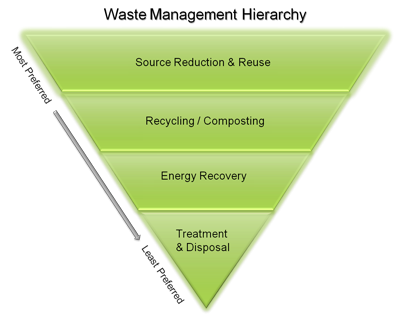Sustainable Materials Management: Non-Hazardous Materials and Waste Management Hierarchy

EPA developed the non-hazardous materials and waste management hierarchy in recognition that no single waste management approach is suitable for managing all materials and waste streams in all circumstances. The hierarchy ranks the various management strategies from most to least environmentally preferred. The hierarchy places emphasis on reducing, reusing, and recycling as key to sustainable materials management.
On this page:
Source Reduction and Reuse
Source reduction, also known as waste prevention, means reducing waste at the source, and is the most environmentally preferred strategy. It can take many different forms, including reusing or donating items, buying in bulk, reducing packaging, redesigning products, and reducing toxicity. Source reduction also is important in manufacturing. Lightweighting of packaging, reuse, and remanufacturing are all becoming more popular business trends. Purchasing products that incorporate these features supports source reduction.
Source reduction can:
- Save natural resources,
- Conserve energy,
- Reduce pollution,
- Reduce the toxicity of our waste, and
- Save money for consumers and businesses alike.
Recycling and Composting
Recycling is a series of activities that includes collecting used, reused, or unused items that would otherwise be considered waste; sorting and processing the recyclable products into raw materials; and remanufacturing the recycled raw materials into new products. Consumers provide the last link in recycling by purchasing products made from recycled content. Recycling also can include composting of food scraps, yard trimmings, and other organic materials.
Benefits of recycling include:
- Preventing the emission of many greenhouse gases and water pollutants;
- Saving energy;
- Suppling valuable raw materials to industry;
- Creating jobs;
- Stimulating the development of greener technologies;
- Conserving resources for our children's future; and
- Reducing the need for new landfills and combustors.
Energy Recovery
Energy recovery from waste is the conversion of non-recyclable waste materials into useable heat, electricity, or fuel through a variety of processes, including combustion, gasification, pyrolization, anaerobic digestion, and landfill gas (LFG) recovery. This process is often called waste-to-energy (WTE). Converting non-recyclable waste materials into electricity and heat generates a renewable energy source and reduces carbon emissions by offsetting the need for energy from fossil sources and reduces methane generation from landfills. After energy is recovered, approximately ten percent of the volume remains as ash, which is generally sent to a landfill.
Treatment and Disposal
Prior to disposal, treatment can help reduce the volume and toxicity of waste. Treatments can be physical (e.g., shredding), chemical (e.g., incineration), and biological (e.g., anaerobic digestor). Landfills are the most common form of waste disposal and are an important component of an integrated waste management system. Modern landfills are well-engineered facilities located, designed, operated, and monitored to ensure compliance with state and federal regulations. Landfills that accept municipal solid waste are primarily regulated by state, tribal, and local governments. EPA, however, established national standards that these landfills must meet in order to stay open. The federal landfill regulations eliminated the open dumps (disposal facilities that do not meet federal and state criteria) of the past. Today’s landfills must meet stringent design, operation, and closure requirements. Methane gas, a byproduct of decomposing waste, can be collected and used as fuel to generate electricity. After a landfill is capped, the land may be used for recreation sites such as parks, golf courses, and ski slopes.
